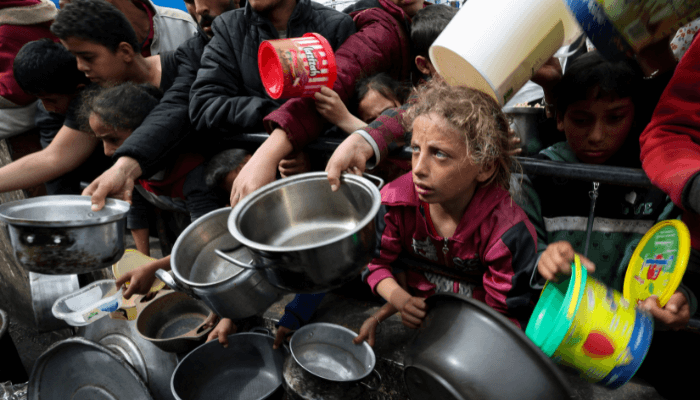A humanitarian aid distribution point in the southern Gaza Strip descended into chaos on Tuesday as thousands of desperate Palestinians surged forward in search of food, prompting Israeli troops to fire warning shots and forcing the temporary withdrawal of US contractors overseeing the site.
The site, operated by the controversial Gaza Humanitarian Foundation (GHF), had only recently begun operations amid a tightening humanitarian catastrophe in the besieged enclave, where an 11-week Israeli blockade has left over two million Palestinians on the brink of famine.
Read also: Former Israeli PM calls Gaza attack ‘war crimes’
Panic and warning shots as aid site overwhelmed
Footage from Tel al-Sultan in Rafah showed massive crowds storming the facility, toppling fences and breaching barriers designed to regulate the flow of people. A Palestinian health official confirmed that one person died of severe injuries at the Red Cross Field Hospital in Rafah and at least 48 others were wounded in the turmoil.
“They want order, but there will be no order,” said Wafiq Qdeih, one of the aid seekers. “These are desperate people who want to eat and drink.”
Witnesses described long, gruelling journeys to reach the site, followed by hours of waiting amid widespread confusion. “I am tired and exhausted,” said Abu Ramzi, another recipient. “Security will not be able to control all these people.”
The Israel Defense Forces (IDF) said troops fired warning shots to disperse the crowd and denied targeting the area with aerial fire. A security source said US contractors did not fire weapons and confirmed that aid distribution resumed on Wednesday.
Read also: Pope Leo XIV calls for ceasefires in Ukraine, Gaza, urges world to reject war
A ‘predictable failure’ and mounting criticism
“This is a big failure that we warned against,” said Amjad al-Shawa, director of the Palestinian Non-Governmental Organizations Network. “Starvation is not a method of aid delivery. It violates humanitarian principles.”
GHF stated it had distributed 8,000 food boxes—amounting to 462,000 meals—so far and aims to reach 1.2 million Gazans, nearly 60% of the population, by the end of the week. Yet critics say the numbers are grossly inadequate and the entire distribution strategy fundamentally flawed.
The United Nations Office for the Coordination of Humanitarian Affairs (OCHA) previously called the plan “practically unfeasible” and warned it could intensify insecurity and violate international law. “It’s a distraction from what is actually needed,” said UN spokesperson Jens Laerke, urging a reopening of Gaza’s border crossings and a safe environment for large-scale aid operations.
Exclusion of Northern Gaza raises alarm
All current and planned GHF distribution sites are located in southern and central Gaza—areas where Israel has ordered mass evacuations. No sites are planned for the north, where conditions are reportedly most dire. Aid experts and UN officials say this could serve Israel’s objective of depopulating northern Gaza.
Read also: Egypt unveils Gaza plan as Arab nations reject Trump proposal
UN Secretary-General António Guterres’ spokesperson, Stephane Dujarric, condemned the scenes at the GHF site as “heartbreaking” and stressed that aid must be distributed “under principles of independence [and] impartiality.”
‘This is not humanitarian aid’
Hardin Lang of Refugees International sharply criticised the US-Israel-backed GHF model as a military-led initiative masquerading as humanitarian relief. “This is not the way you try to feed a population on the verge of famine,” he said. “It’s been designed to relocate people to what Israel calls a ‘humanitarian zone’, not to meet their actual needs.”
Ahmed Bayram of the Norwegian Refugee Council went further, calling for the initiative’s immediate cancellation.
“This is not how aid is done. An occupying power, which flattened Rafah and displaced its residents, cannot now credibly ask them to return for aid,” he said.
Aid delivery
Images shared by the GHF, whose boxes bore the logo of Michigan-based charity Rahma Worldwide, showed relatively empty lots with only a handful of aid recipients—at odds with the scenes of chaos reported on the ground.
Despite the day’s violence, Israeli Prime Minister Benjamin Netanyahu downplayed the severity of the incident.
“There was some loss of control momentarily. Happily, we brought it back under control,” he said. Netanyahu also denied that widespread malnutrition exists in Gaza, remarking, “You don’t see one, not one emaciated person.”
His claims stand in sharp contrast to reports from humanitarian agencies and Palestinian officials, who warn of starvation, mounting civilian deaths, and widespread displacement as Israel continues its offensive.
600 days into war, humanitarian disaster worsens
Wednesday marks 600 days since the war began following Hamas’ October 7 attacks. Israel now plans to occupy 75 percent of Gaza within two months, which would further displace an already vulnerable population into an ever-shrinking corner of the devastated enclave.
As aid operations falter under military oversight, the UN’s Philippe Lazzarini condemned Tuesday’s events as “chaotic, undignified and unsafe.”
“What we saw was not aid. It was a distraction from the atrocities still unfolding,” he said.
The situation remains critical. Humanitarian agencies continue to call for full access, safe distribution methods, and an end to the blockade, warning that anything short of this will fail to prevent a famine that is no longer a threat but a present reality for millions.

